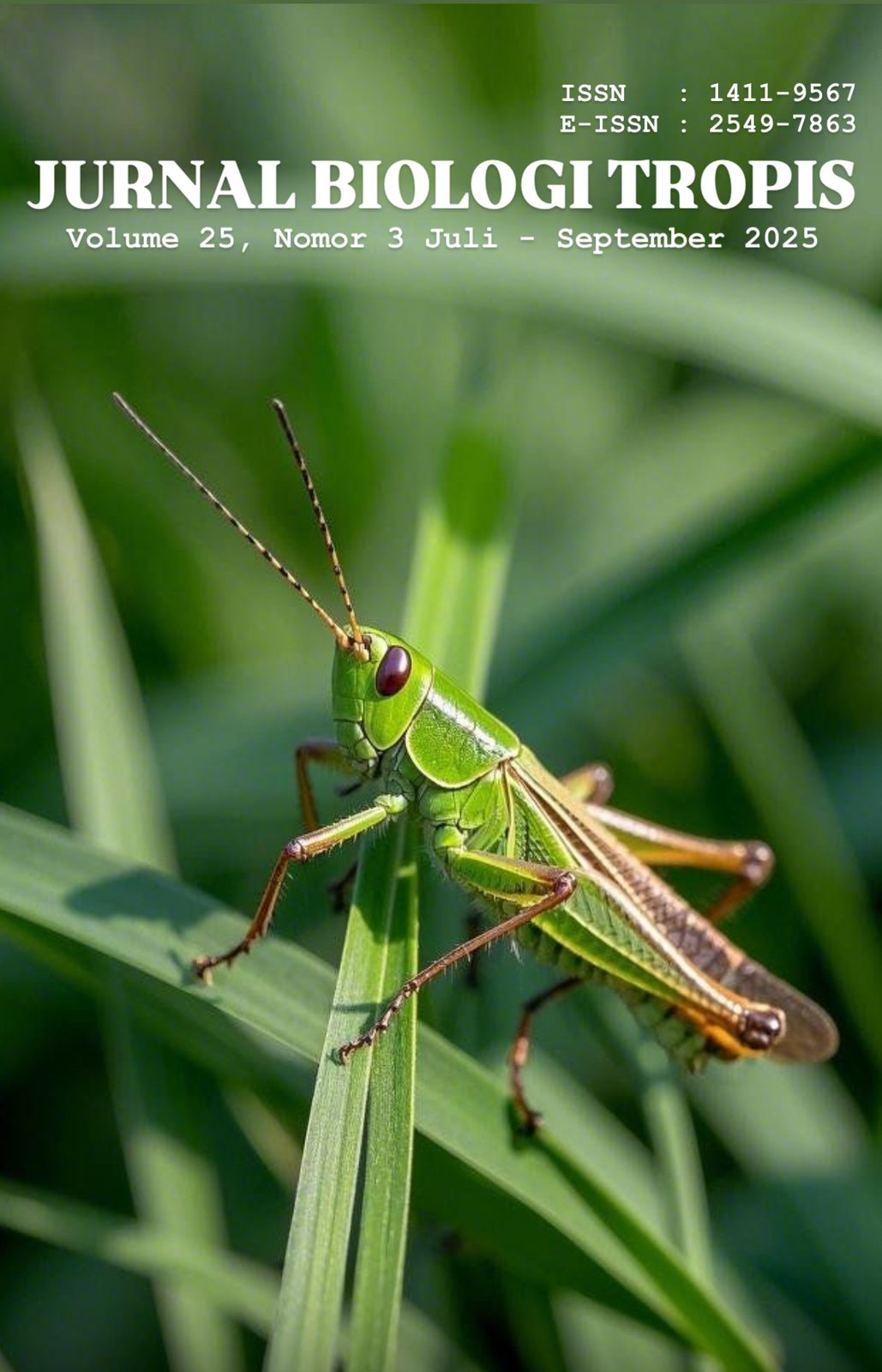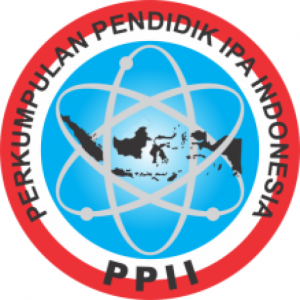Literature Review: Analysis of Cyanogenic Compounds in Plants
Authors
Zozy Aneloi Noli , Enda Tarni Asih , Gusti Ari Afrilya Pasha , Marhamah Siagian , Sabbrina Adelia , Suci Indah Putri , Putra SantosoDOI:
10.29303/jbt.v25i3.9417Published:
2025-07-09Issue:
Vol. 25 No. 3 (2025): Juli-SeptemberKeywords:
Cyanide, cyanogenic, cyanogenic glycoside.Articles
Downloads
How to Cite
Downloads
Metrics
Abstract
Cyanogenic glycosides are hydrocarbon compounds that can bind to CN groups and sugars. Certain plants, notably higher plants, can perform cyanogenesis, forming cyanogenic glycosides as by-products of biochemical reactions. From a medical perspective, cyanide is known to negatively impact health, particularly the respiratory system, as it binds oxygen in the blood to toxic compounds. Symptoms of cyanide poisoning from food consumption include dizziness, weakness, vomiting, throat inflammation, and abdominal cramps. Acute poisoning and death have been reported from consuming food containing 50 – 100 mg of cyanide. This review utilizes a literature study method, focusing on national journals from the past decade accessed via Google Scholar. The findings identify five plant species containing cyanogenic glycosides: cassava, bamboo shoots, cassava leaves, raw Pangium edule seeds, and Dioscorea hispida tubers. Cassava, in particular, contains linamarin, a cyanogenic glycoside found in all parts of the plant, with bitter varieties generally having higher toxin levels.
References
Abdelnour, S. A., Abd El-Hack, M. E., & Ragni, M. (2018). The efficacy of high-protein tropical forages as alternative protein sourcesfor chickens: A review. Agriculture, 8(6): 86. DOI: https://doi.org/10.3390/agriculture8060086
Arianti, M. D., Lestari, L., & Puspitasari, A. (2020). Perbandingan kadar sianida menggunakan metode asam pikrat dan ninhidrin pada umbi gadung yang direbus. Jurnal Analis Kesehatan Sains, 9(2): 846-852.
Ariani, L. N., Estiasih, T., & Martati, E. (2017). Karakteristik sifat fisiko kimia ubi kayu berbasis kadar sianida. Jurnal teknologi pertanian, 18(2): 119-128.
Arisanti, D., Rasyid, N. Q., & Nasir, M. (2018). Analisis Kadar Sianida Pada Rebung Berdasarkan Volume Ukuran Dari Kecamatan Bajeng Kabupaten Gowa. Indonesian Journal of Chemical Research, 6(1): 6-11.
Bekhit, A. E. D. A., Shavandi, A., Jodjaja, T., Birch, J., Teh, S., Ahmed, I. A. M., ... & Bekhit, A. A. (2018). Flaxseed: Composition, detoxification, utilization, and opportunities. Biocatalysis and agricultural biotechnology, 13: 129-152. DOI: https://doi.org/10.1016/j.bcab.2017.11.017
Bolarinwa, I. F., Oke, M. O., Olaniyan, S. A., & Ajala, A. S. (2016). A review of cyanogenic glycosides in edible plants. IntechOpen. DOI: 10.5772/64886
Chauhan, V. B. S., Mallick, S. N., Pati, K., Arutselvan, R., & Nedunchezhiyan, M. (2022). Status and Importance of Underexploited Tuber Crops in Relation to Nutritional Security and Economic Prosperity. Compendium for Winter School on “Unexpected Vegetables: Unexplored Treasure Trove for Food, Nutritional and Economic Security, 246-264.
Cowan, M., Møller, B. L., Norton, S., Knudsen, C., Crocoll, C., Furtado, A., ... & Gleadow, R. M. (2022). Cyanogenesis in the Sorghum genus: from genotype to phenotype. Genes, 13(1): 140. DOI: https://doi.org/10.3390/genes13010140
Cressey, P., & Reeve, J. (2019). Metabolism of cyanogenic glycosides: A review. Food and chemical toxicology, 125: 225-232. DOI: https://doi.org/10.1016/j.fct.2019.01.002
Dwijayanti, E. (2023). Pengaruh Waktu Perendaman terhadap Penurunan Kadar Asam Sianida Ubi Kayu Pahit (Manihot palmate) asal Tual Maluku Tenggara. Bohr: Jurnal Cendekia Kimia, 2(01): 36-42.
Erinda, S. (2021). Uji Organoleptik Pemanfaatan Garam dan Abu Dapur terhadap Detoksifikasi Umbi Gadung (Dioscorea Hispida Dennst) dalam Pembuatan Tepung. Jurnal sosial dan sains, 1(8): 881-891. DOI: https://doi.org/10.59188/jurnalsosains.v1i8.182
Gidlow, D. (2017). Hydrogen cyanide—An update. Occupational Medicine, 67(9): 662-663. DOI: https://doi.org/10.1093/occmed/kqx121
Gouveia, C. S., Ganança, J. F., Lebot, V., & de Carvalho, M. Â. P. (2018). Quantitation of oxalates in corms and shoots of Colocasia esculenta (L.) Schott under drought conditions. Acta physiologiae plantarum, 40: 1-11.
Hasyim, D. M., Nugraha, Y. R., & Muharam, F. (2024). Analisis Kadar Sianida pada Biji Petai Cina Mentah (Leucaena leucocephala (Lam.) de Wit) Asal Cisompet Kabupaten Garut dengan Metode Spektrofotometri UV-Vis. Innovative: Journal Of Social Science Research, 4(4): 9705-9715. DOI: https://doi.org/10.31004/innovative.v4i4.14300
Imakumbili, M. (2019). Determination of Total Hydrogen Cyanide Levels in Fresh Cassava Roots using the picrate paper method. Plos One, 3: 1-13. DOI: https://dx.doi.org/10.17504/protocols.io.2emgbc6
Joshi, V. K., Abrol, G. S., & Singh, A. K. (2020). Anti-nutritional factors in food and plant crops. International Journal of Food and Fermentation Technology, 10(2): 101-111. DOI: http://dx.doi.org/10.30954/2277-9396.02.2020.6
Khansa, B., Khoiriyah, A. N., Fathanisa, A., & Hayaa, N. S. (2025). Effects Of Combined Exposure To Carbon Monoxide And Hydrogen Cyanide In Forensic Cases: A Literature Study. Jurnal Kesehatan Farmasi, 7(1): 105-113.
Mardiyono, M. (2020). Penetapan kadar asam sianida padatalas (Colocasia esculenta) denganvariasi waktu perendaman secara argentometri. Jurnal Analis Farmasi, 5(1): 30-37. DOI: https://doi.org/10.33024/jaf.v5i1.3976
Mosayyebi, B., Imani, M., Mohammadi, L., Akbarzadeh, A., Zarghami, N., Edalati, M., ... & Rahmati, M. (2020). An update on the toxicity of cyanogenic glycosides bioactive compounds: Possible clinical application in targeted cancer therapy. Materials Chemistry and Physics, 246: 122841. DOI: https://doi.org/10.1016/j.matchemphys.2020.122841
Ndam, Y. N., Mounjouenpou, P., Kansci, G., Kenfack, M. J., Meguia, M. P. F., Eyenga, N. S. N. N., ... & Nyegue, A. (2019). Influence of cultivars and processing methods on the cyanide contents of cassava (Manihot esculenta Crantz) and its traditional food products. Scientific African, 5: e00119. DOI: https://doi.org/10.1016/j.sciaf.2019.e00119
Nivetha, N., Suvarna, V. C., & Abhishek, R. U. (2018). Reduction of phenolics, tannins and cyanogenic glycosides contents in fermented beverage of linseed (Linum usitatissimum). International Journal of Food and Fermentation Technology, 8(2): 185-190. DOI: 10.30954/2277-9396.02.2018.8
Niyogi, A., Bhattacharyya, S., Pal, S., Mukherjee, S., & Ghosh, A. (2025). Uncovering Taxiphyllin in bamboo shoots: An analytical perspective. Food chemistry, 144048. DOI: https://doi.org/10.1016/j.foodchem.2025.144048
Nurhidayanti, N., Aristoteles, A., & Apriantari, A. (2021). Uji kadar asam sianida pada ubi kayu (Manihot escullenta) dengan perendaman NaCl dan NaHCO3 Menggunakan Spektrofotometer UV-Vis. Sainmatika: Jurnal Ilmiah Matematika dan Ilmu Pengetahuan Alam, 18(2): 138-145.
Nyirenda, K. K. (2020). Toxicity potential of cyanogenic glycosides in edible plants. Medical toxicology, 1-19.
Olaniyan, S. A. (2016). A Review of Cyanogenic Glycosides in Edible Plants. Toxicology: New Aspects to This Scientific Conundrum, 179. DOI: http://dx.doi.org/10.5772/64886
Padilla-González, G. F., Sadgrove, N. J., Rosselli, A., Langat, M. K., Fang, R., & Simmonds, M. S. (2021). Cyanogenic Derivatives as Chemical Markers for the Authentication of Commercial Products of Bamboo Shoots. Journal of Agricultural and Food Chemistry, 69(34): 9915-9923.
Panter, K. E. (2018). Cyanogenic glycoside–containing plants. In Veterinary toxicology (pp. 935-940). Academic Press. DOI: https://doi.org/10.1016/B978-0-12-811410-0.00064-7
Parvathy, S. T., & Sheela, M. N. (2024). Genetic Modification of Tropical Root and Tuber Crops: Prospects and Perspectives. Genetic Engineering of Crop Plants for Food and Health Security, 2: 119-164. DOI: https://link.springer.com/chapter/10.1007/978-981-97-3119-0_6
Pratiwi, D., Masyrofah, D., Martia, E., Putri, G. K., & Putri, T. R. (2023). Review artikel: analisis senyawa sianogenik pada tanaman. Jurnal Farmasetis, 12(1): 9-14.
Rivadeneyra-Domínguez, E., & Rodríguez-Landa, J. F. (2020). Preclinical and clinical research on the toxic and neurological effects of cassava (Manihot esculenta Crantz) consumption. Metabolic brain disease, 35: 65-74. DOI: https://link.springer.com/article/10.1007/s11011-019-00522-0
Rizk, A. F. M., & El-Missiry, M. M. (2018). Non-diterpenoid constituents of Euphorbiaceae and Thymelaeaceae. In Naturally Occurring Phorbol Esters. 107-138. CRC Press.
Rubina Noreen, H., Rahman, A., Shafique, H. A., Sultana, V., & Ehteshamul-Haque, S. (2018). Biocontrol and plant growth promoting potential of endo-nodule fluorescent Pseudomonas and rhizobia associated with root nodules of Leucaena leucocephala. Int. J. Biol. Res, 6(1): 15-26. DOI:
Sari, E. M., & Nurfajriah, S. (2022). Perbandingan Senyawa Sianida Pada Daun Singkong Dengan Perendaman Nahco3 Dan Ca(Oh)2. Journal of research and education chemistry, 4(1): 9-9. DOI: https://doi.org/10.25299/jrec.2022.vol4(1).9332
Sathischandra, M. K. D. P. M. (2022). Effects of processing methods of cassava (Manihot esculanta) leaves on detoxification of cyanogenic compounds: A short review. Journal of Agriculture and Value Addition, 5(1): 115-120. DOI: https://doi.org/10.4038/java.v5i1.38
Suharti, S., Sulastri, Y., & Alamsyah, A. (2019). Pengaruh lama perendaman dalam larutan nacl dan lama pengeringan terhadap mutu tepung talas belitung (Xanthosoma sagittifolium): The Effect of NaCl Soaking Time and Drying Time on The Quality of Belitung Taro Flour (Xanthosoma sagittifolium). Pro Food, 5(1): 402-413. DOI: https://doi.org/10.29303/profood.v5i1.96
Tahir, F., Ali, E., Hassan, S. A., Bhat, Z. F., Walayat, N., Nawaz, A., ... & Aadil, R. M. (2024). Cyanogenic glucosides in plant-based foods: Occurrence, detection methods, and detoxification strategies–A comprehensive review. Microchemical Journal, 199, 110065.
Thathsarani, N., Jayasinghe, C. D., Jayawardena, U., & Nilakarawasam, N. (2021). Effect of oral administration of the fresh juice of Bamboo (Bambusa vulgaris) young shoots on enumeration of bone marrow cells, platelets, splenocyte and phagocytic activity of peritoneal macrophages of rats. Phytomedicine Plus, 1(3): 100059. DOI: https://doi.org/10.1016/j.phyplu.2021.100059
Tewe, O. O., & Iyayi, E. A. (2023). Cyanogenic glycosides. In Toxicants of plant origin (pp. 43-60). CRC Press.
Triana, L., & Kamila, L. (2018). Analisis kadar asam sianida pada ubi kayu yang direndam dalam larutan nahco3 20% dengan variasi waktu. Jurnal Laboratorium Khatulistiwa, 1(2): 130-136. DOI: https://doi.org/10.30602/jlk.v1i2.150
Wahyu, W., Rahayuni, T., & Purwayantie, S. (2020). Pengaruh Konsentrasi Abu Sekam dan Lama Perendaman Terhadap Penurunan Asam Sianida pada Tepung Umbi Galli (Lasio spinosa). FoodTech: Jurnal Teknologi Pangan, 3(2): 47-57.
Wulandari, W., & Zulfadli, Z. (2017). Uji Kualitatif Kandungan Sianida dalam Rebung (Dendrocalamus asper), Umbi Talas (Colocasia esculenta), dan Daun Singkong (Manihot utilissima phol). Jurnal Edukasi Kimia (JEK), 2(1): 41-47.
Yulvianti, M., & Zidorn, C. (2021). Chemical diversity of plant cyanogenic glycosides: an overview of reported natural products. Molecules, 26(3): 719. DOI: https://doi.org/10.3390/molecules26030719
License
Copyright (c) 2025 Zozy Aneloi Noli, Enda Tarni Asih, Gusti Ari Afrilya Pasha, Marhamah Siagian, Sabbrina Adelia, Suci Indah Putri, Putra Santoso

This work is licensed under a Creative Commons Attribution 4.0 International License.

Jurnal Biologi Tropis is licensed under a Creative Commons Attribution 4.0 International License.
The copyright of the received article shall be assigned to the author as the owner of the paper. The intended copyright includes the right to publish the article in various forms (including reprints). The journal maintains the publishing rights to the published articles.
Authors are permitted to disseminate published articles by sharing the link/DOI of the article at the journal. Authors are allowed to use their articles for any legal purposes deemed necessary without written permission from the journal with an acknowledgment of initial publication to this journal.


























